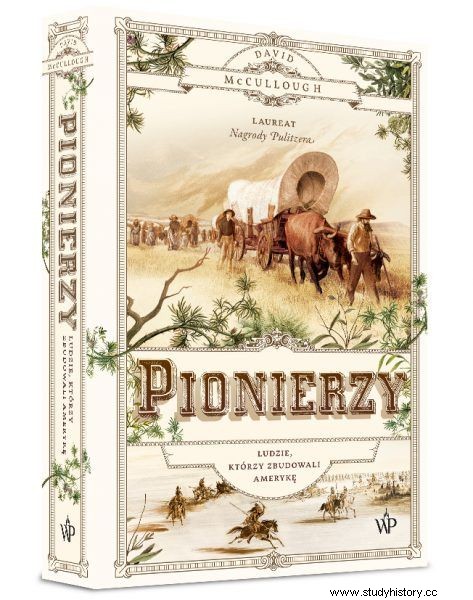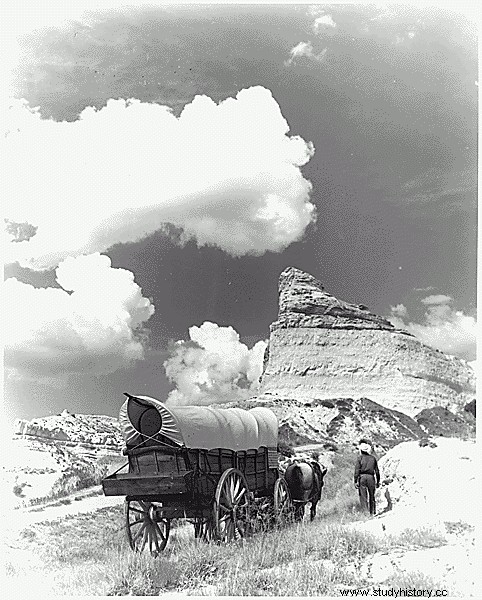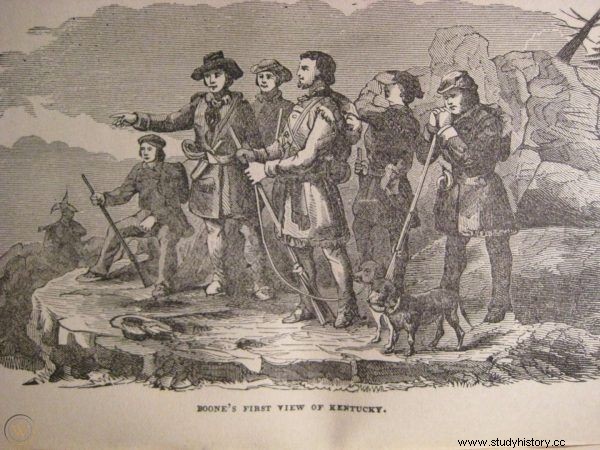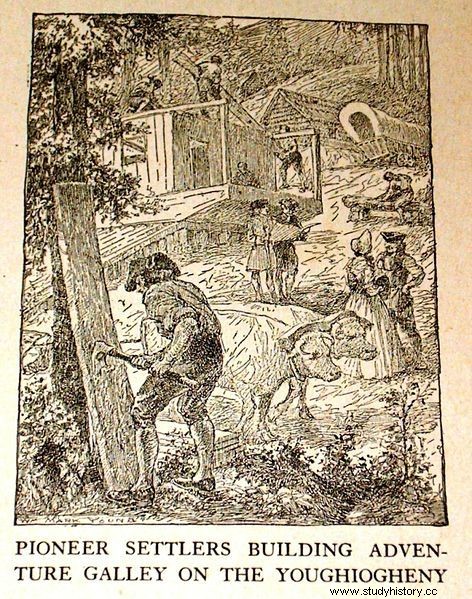After the War of Independence ended with the Peace of Versailles in 1783, the Americans gained new territories over which the British had so far ruled. A huge, resource-rich territory northwest of the Ohio River was waiting for white settlers.
In mid-August, the Reverend Manasseh Cutler arrived at Marietta:he traveled all the way from Ipswich Hamlet, or 1,209 kilometers, in just twenty-nine days, setting a new record. Due to the fact that he would be away from home for at least three months and not fulfill his pastoral duties, he renounced his salary before setting off.
A challenging journey
He reached the Allegheny Mountains in a horse-drawn carriage called sulki, rode over the mountains, and then down Ohio by barge. During the journey he was plagued by frequent rains and fogs, he traversed "exceptionally" poor roads, "frightening" elevations and descents, and stopped at exceptionally poor roadside taverns. But all this time it was summer, so the journey was nothing like what Rufus Putnam and his men must have experienced.

The article is an excerpt from the book Pionierzy. The People Who Built America , which was recently released on the market by Wydawnictwo Poznańskie.
On a voyage down the "very romantic" Ohio River, Cutler had the pleasure of being with General Benjamin Tupper, his wife, their five children and two grandchildren, as well as four other families, making a total of thirty-six settlers heading to Marietta, including fourteen children.
This was the first group of families to settle in a new location, and all fathers were Revolutionary War veterans, and therefore gifted with an experience they knew well enough to prepare them for the challenges ahead in the best possible way. As Joseph Baker, another distinguished veteran who was to come to Ohio later, wrote
in the revolutionary army they received a second education, there they learned the commandments of wisdom and saw examples of bravery and fortitude. They were taught discipline and the benefits of obedience to law and good order, which served the well-being and happiness of themselves and of all mankind.
A warm welcome
There was a large crowd at Point:people cheered, dogs barked. The welcoming committee included Rufus Putnam, Samuel Parsons and Winthrop Sargent, among others. But Jervis Cutler was nowhere to be seen, whose rowdy spirit, as his father already knew, must have led him somewhere else.
The first reactions of the newcomers to the conditions in their new home, if it was going to be Campus Martius, they were mostly positive. As one of General Tupper's daughters wrote:“The buildings are decent and comfortable. The Indians seem completely friendly, she said, but still added, "There is a watch every night."

Covered cars made traveling easier
With his characteristic eagerness, Manasseh Cutler decided to see whatever he could, and to fully enjoy the hospitality of the settlers and the progress of their work. A joint effort was made to "build huts" to provide new neighbors with a place to live, and thanks to the collaboration of the settlers, one hut was created in a surprisingly short time. The usual payment for such help was whiskey donated in generous amounts.
Accompanied by Rufus Putnam, Cutler walked around the "city plots" and the cornfield, the size of which "amazed him," as did the corn itself, which had grown to an unimaginable height of four meters. One of the tulip trees was nearly two meters in diameter and, according to Cutler, more than four hundred years old.
Amazing nature
No wonder it was the trees that caught Cutler's attention the most. He could be seen studying and measuring the trunks of felled trees, carefully counting their rings. A plane tree was 6.5 meters in circumference, and on the trunk of one of the elms the pastor counted three hundred and thirty-six clearly marked rings.
Together with Generals Parsons and Varnum, he had a close look at the "great tree," that is, the enormous hollow black walnut just off the banks of the Muskingum. At a height of 50 centimeters above the ground, its trunk was 12.5 meters in circumference. As Cutler was told, it could fit six people on horses at once.
As always, Cutler took time to describe his daily activities, paying particular attention to the wonders of nature he saw. One day he dissected the copperhead's poisonous moccasin.
I cut off his head and examined his teeth. From the pouch on one side of the jaw, I took out seven teeth. I found a round bone where the teeth were seated; the bone is connected to the jaw by a strong ligament.

For many people, America was a chance for a new life
For most of Cutler's visit, the area was hit by sudden, violent downpours, in which the pastor “nearly drowned,” coupled with fumes, fog, and the ubiquitous mud. Fortunately, all the women he met found him joyful and charming. Miss Anna Symmes was a "carefully educated young lady" (she would be married to President William Henry Harrison in the future). He considered Mrs. Harmar, the general's wife, a "beautiful woman," and at a dinner hosted by Captain William McCurdy, which served squirrel patties, he had a "very pleasant" time with Mrs. McCurdy.
As might be expected, Cutler was fascinated by the Great Mound and loved to discuss it.
The reality of life
On one occasion he was called in the middle of the night to a seriously ill child of one couple with whom he was traveling in Ohio. But when he arrived at their cabin, thirteen-month-old Nabby Cushing was already dead. The girl's death was the first among the settlers who came to Marietta. The parents had six more children, and in the winter they expected another one to be born.
Cutler was immensely pleased with the conspicuous presence of natives of various tribes in the day-to-day life of the settlement.
Some Indians eat with us almost every day, mainly Delawars, Wyandots, one or two Shaunis, Mingas, Senecs or Iroquois. No other tribes appear.
The Chepeweys and Ottaws, he was told, seemed belligerent. The only time the pastor complained about the natives was when he returned to the camp at night and found many Indians there, with the "squaws being mostly drunk."
On Sunday, August 24, the Reverend Cutler gave a thrilling sermon to the large assembly of the faithful at Campus Martius. He spoke for a long time, apparently having thought carefully about his words.
The most important issues raised in the sermon were the person of God and the Good News. But also freedom of religion, knowledge and a new, emerging nation.

American pioneers at work
It can be firmly stated that a new Empire was born and a new creation appeared on earth. The now introduced US Constitution guarantees both religious and civil freedoms.
Some committed Christians may tremble for our Ark and believe that the Christian faith will be put in danger when it is removed from the patronage of civil authority. They may fear the invasion of promiscuity and infidelity on the one hand, and sectarianism and division on the other. We will cast off our fears, however, when we understand that the truth can never be really threatened, as long as there is enough light, knowledge, and freedom to defend it.
Cutler spoke with patriotic fervor, he was undoubtedly filled with pride and faith in the emerging society and its values, and he was optimistic about the future.
Such is the current state of affairs in this country that we have just gained ground to trust that religion and knowledge, useful and ornamental sciences, will be supported and will reach the remotest corners of the American empire. (…) Here we are seeing a land with a vast area, mild climate, fertile soil and conducive to the joys of life. (...) Let the Good News be preached here until the end of time; let art and science be sown; may the seeds of virtue, happiness and glory be firmly established and grow to full maturity.
Traffic on the Ohio River had gradually increased, but so far people had driven mostly further south to Virginia and Kentucky. Ten to twelve boats sailed there daily, targeting Kentucky. By the end of the year, more than nine hundred boats had passed the "New England settlement," as Marietta was sometimes called, with a total of eighteen thousand on board. The spectacle itself was the wealth of shapes and sizes of means of transport crossing the river:there were flat-bottomed boats, rafts, barges of various sizes and galleys. The flat-bottomed boats resembled heavy rectangular boxes 250-300 centimeters wide and 9-12 meters long. Described as "a combination of a log cabin, a fort, a floating farm and a village shop", they were the main means of transport for "incoming pilgrims".
John James Audubon, who went to Ohio on his honeymoon, described the other passengers crowding with his flock and birds:
The roof or deck of the boat did not differ much from the country yard, it was covered with hay, plowshares, carts and carts (...), the matron reels were also striking. Even the sides of this floating body were loaded with wheels of various vehicles, which were themselves resting on the roof.
Boats
At the end of the journey, such a flat-bottomed boat was broken into pieces and the wood was used for various purposes.
Galley-like boats called keelboats were used to travel both up and down the river. The Keelboats, it was said, "heralded the coming of a new era." They were long, narrow boats from 15 to 21 meters, 4.5-5.5 meters wide, with shallow draft, pointed nose and stern, and a narrow platform running along both sides. The crew consisted of men who, moving along the platform, pushed themselves from the bottom with long poles and moved the boat upstream. Or they just used oars.
In certain situations it was better to grasp the bushes and trees along the banks and pull the boat forward in this way. This method was known as "breaking through the bush".

The article is an excerpt from the book Pionierzy. The People Who Built America , which was recently released on the market by Wydawnictwo Poznańskie.
There was no harder work in the new western area than that of the skippers of such boats, who for many years had been a colorful part of life on the river, a "separate class" of people distinguished by red flannel shirts and woolen hats with feathers. The hands of experienced skippers also reflected their off-hours lifestyle, many of them also had broken noses, torn ears or facial scars, which they were also very proud of. As one historian on the Ohio River wrote cautiously:If a city had a really bad reputation, it was the perfect place for them to stop in and have a little fun. Of course, their entertainment did not bring peace in the place they chose to rest .
The article is an excerpt from the book Pionierzy. The People Who Built America , which was recently released on the market by Wydawnictwo Poznańskie.
